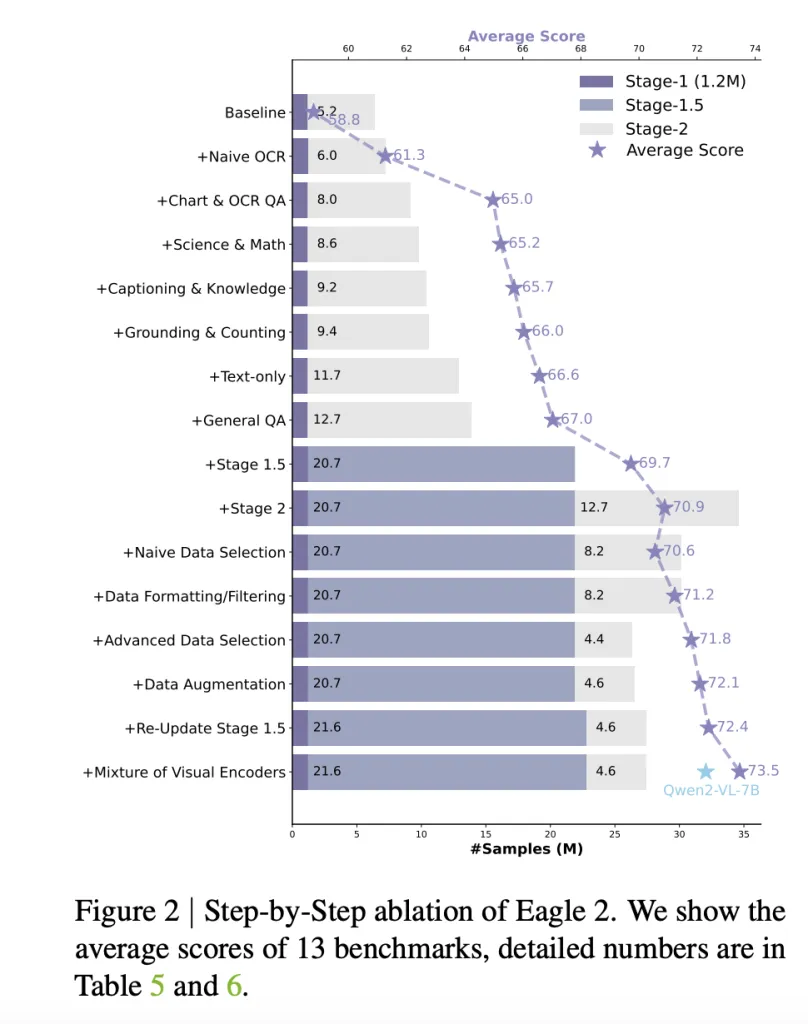

Vision-Language Models (VLMs) have significantly expanded AI’s ability to process multimodal information, yet they face persistent challenges. Proprietary models such as GPT-4V and Gemini-1.5-Pro achieve remarkable performance but lack transparency, limiting their adaptability. Open-source alternatives often struggle to match these models due to constraints in data diversity, training methodologies, and computational resources. Additionally, limited documentation on post-training data strategies makes replication difficult. To address these gaps, NVIDIA AI introduces Eagle 2, a VLM designed with a structured, transparent approach to data curation and model training.
NVIDIA AI Introduces Eagle 2: A Transparent VLM Framework
Eagle 2 offers a fresh approach by prioritizing openness in its data strategy. Unlike most models that only provide trained weights, Eagle 2 details its data collection, filtering, augmentation, and selection processes. This initiative aims to equip the open-source community with the tools to develop competitive VLMs without relying on proprietary datasets.
Eagle2-9B, the most advanced model in the Eagle 2 series, performs on par with models several times its size, such as those with 70B parameters. By refining post-training data strategies, Eagle 2 optimizes performance without requiring excessive computational resources.


Key Innovations in Eagle 2
The strengths of Eagle 2 stem from three main innovations: a refined data strategy, a multi-phase training approach, and a vision-centric architecture.
- Data Strategy
- The model follows a diversity-first, then quality approach, curating a dataset from over 180 sources before refining it through filtering and selection.A structured data refinement pipeline includes error analysis, Chain-of-Thought (CoT) explanations, rule-based QA generation, and data formatting for efficiency.
- Stage 1 aligns vision and language modalities by training an MLP connector.Stage 1.5 introduces diverse large-scale data, reinforcing the model’s foundation.Stage 2 fine-tunes the model using high-quality instruction tuning datasets.
- The model integrates SigLIP and ConvNeXt as dual vision encoders, enhancing image understanding.High-resolution tiling ensures fine-grained details are retained efficiently.A balance-aware greedy knapsack method optimizes data packing, reducing training costs while improving sample efficiency.
These elements make Eagle 2 both powerful and adaptable for various applications.


Performance and Benchmark Insights
Eagle 2’s capabilities have been rigorously tested, demonstrating strong performance across multiple benchmarks:
- Eagle2-9B achieves 92.6% accuracy on DocVQA, surpassing InternVL2-8B (91.6%) and GPT-4V (88.4%).In OCRBench, Eagle 2 scores 868, outperforming Qwen2-VL-7B (845) and MiniCPM-V-2.6 (852), highlighting its strengths in text recognition.MathVista performance improves by over 10 points compared to its baseline, reinforcing the effectiveness of the three-stage training approach.ChartQA, OCR QA, and multimodal reasoning tasks show notable improvements, outperforming GPT-4V in key areas.
Additionally, the training process is designed for efficiency. Advanced subset selection techniques reduced dataset size from 12.7M to 4.6M samples, maintaining accuracy while improving data efficiency.

Conclusion
Eagle 2 represents a step forward in making high-performance VLMs more accessible and reproducible. By emphasizing a transparent data-centric approach, it bridges the gap between open-source accessibility and the performance of proprietary models. The model’s innovations in data strategy, training methods, and vision architecture make it a compelling option for researchers and developers.
By openly sharing its methodology, NVIDIA AI fosters a collaborative AI research environment, allowing the community to build upon these insights without reliance on closed-source models. As AI continues to evolve, Eagle 2 exemplifies how thoughtful data curation and training strategies can lead to robust, high-performing vision-language models.
Check out the Paper, GitHub Page and Models on Hugging Face. All credit for this research goes to the researchers of this project. Also, don’t forget to follow us on Twitter and join our Telegram Channel and LinkedIn Group. Don’t Forget to join our 70k+ ML SubReddit.
 Meet IntellAgent: An Open-Source Multi-Agent Framework to Evaluate Complex Conversational AI System (Promoted)
Meet IntellAgent: An Open-Source Multi-Agent Framework to Evaluate Complex Conversational AI System (Promoted)
The post NVIDIA AI Releases Eagle2 Series Vision-Language Model: Achieving SOTA Results Across Various Multimodal Benchmarks appeared first on MarkTechPost.

